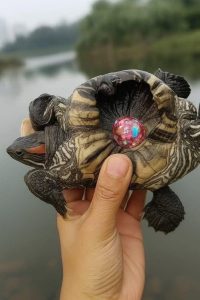
At first glance, a painted turtle shell might seem like an act of innocent creativity—bright colors, playful patterns, maybe even a name scrawled across the curve of its back. But behind that seemingly artistic gesture lies a painful truth: painting a turtle’s shell is not art. It’s cruelty.
Beneath its hard exterior, a turtle’s shell is not just “armor”—it is living tissue. Rich with nerves, blood vessels, and deeply sensitive to its environment, the shell is a crucial part of a turtle’s biological system. It is how they regulate temperature, absorb sunlight, fight infections, and even breathe to a degree.
🐢 The Science You Don’t See
Turtles, like all reptiles, rely on sunlight to produce vitamin D3, a vital nutrient that allows them to process calcium. This calcium is essential not only for bone health but also for the very structure and strength of the shell itself. When someone paints a turtle’s shell—even with non-toxic paint—it acts as a barrier, blocking UV rays and slowly starving the turtle of the light it needs to survive.
But it doesn’t stop there.
The paint seals in bacteria and fungi that would normally be killed by natural exposure to sunlight and air. What follows is often a slow, hidden suffering—chronic infections, shell rot, respiratory issues, and eventually, a death in silence.
😔 What Looks Cute Can Kill
Whether it’s done for a school project, a social media trend, or “just for fun,” painting a turtle’s shell reflects a devastating lack of awareness about what these creatures need to live. In many cases, turtles that are painted lose their natural camouflage and become more vulnerable to predators in the wild. Others die of paint toxicity, their bodies too delicate to survive the chemicals applied to them.
“It’s like spray-painting a pet’s lungs shut,” said one wildlife rehabber. “You’re not just painting over something hard. You’re painting over life.”
🧼 The Aftermath Isn’t Easy
Wildlife rescuers report that removing paint from a turtle’s shell is a long, painful process that often requires months of care. In some cases, layers of shell are so damaged from the chemicals that they begin to flake off, exposing nerves and tissues. By the time a painted turtle is rescued, the damage is often irreversible.
🛑 It’s Time to Speak Up
This is a call to action—not just for wildlife lovers, but for educators, parents, and pet owners. Awareness saves lives.
Turtles cannot cry out. They cannot tell us they’re in pain. But they feel it, deeply and silently.
What we call “decoration” is often their death sentence.
✅ What You Can Do:
-
Educate others: Especially children, about why turtles should never be painted.
-
Speak out if you see painted turtles at pet stores, events, or on social media.
-
Support wildlife rescues that rehabilitate turtles harmed by this practice.
-
Report animal cruelty to local authorities or animal welfare groups.
Never paint a turtle’s shell.
Never turn a life into a canvas.
It’s not art. It’s suffering.
Let’s protect those who can’t protect themselves.
By flex9